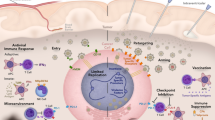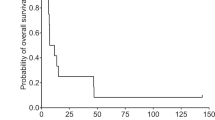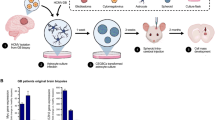Abstract
HSV1716 is a selectively replication competent mutant of herpes simplex virus which is in trial in glioma patients. We have demonstrated that HSV1716 is non-toxic when delivered into tumour or into brain adjacent to tumour, yet replicates within tumour cells. Tumour tissue, from one patient treated 2.5 years previously with intra-tumoural HSV1716, was put into culture. The cultured cells were shown to be glial in origin with no evidence of residual HSV1716. These cells were subsequently infected at a MOI of 0.1 with either HSV1716 or wild-type HSV17+. The HSV17+ infected cells were completely rounded up or lysed within 72 h. Although the cells supported HSV1716 replication and also became rounded or lysed, a proportion (~20%) remained viable. These cells continued to divide and shed low levels of HSV1716 up to 31 days after infection when there was evidence of rapid virus replication resulting in complete cell lysis. These data demonstrate that HSV1716 can ‘persist’ in human glioma cells at least in vitro and gives credence to the possibility that in tumours in vivo a similar phenomenon may take place. If this were the case, then HSV1716 has the potential to kill tumour cells over a prolonged period of time.
This is a preview of subscription content, access via your institution
Access options
Subscribe to this journal
Receive 12 print issues and online access
$259.00 per year
only $21.58 per issue
Buy this article
- Purchase on Springer Link
- Instant access to full article PDF
Prices may be subject to local taxes which are calculated during checkout





Similar content being viewed by others
References
MacLean AR et al. Herpes simplex virus type 1 deletion variants 1714 and 1716 pinpoint neurovirulence related sequences in Glasgow strain 17 between immediate early gene 1 and the ‘a’ sequence J Gen Virol 1991 1991 72: 631–639
McKie EA et al. Selective in vitro replication of herpes simplex virus type 1 (HSV1), ICP34.5 null mutants in primary human CNS tumours-evaluation of a potentially effective clinical therapy Br J Cancer 1996 74: 745–752
Brown SM et al. Cell type and cell state determine differentiated in vitro growth of non-neurovirulent ICP34.5 negative herpes simplex virus J Gen Virol 1994 75: 2367–2377
Papanastassiou VT et al. The potential for efficacy of the modified (ICP34.5−) herpes simplex virus HSV1716 following intratumoural injection into human malignant glioma: a proof of principle study Gene Therapy 2002 9: 398–406
Rampling R et al. Toxicity evaluation of replication competent herpes simplex virus (ICP 34.5 null mutant 1716) in patients with recurrent malignant glioma Gene Therapy 2000 7: 859–866
MacKie RM, Stewart BJ, Brown SM . Intralesional injection of herpes simplex virus 1716 in patients with metastatic melanoma The Lancet 2001 358: 525–526
Brown SM, MacLean AR, McKie EA, Harland J . The herpes simplex virus virulence factor ICP34.5 and the cellular protein MyD116 complex with proliferating cell nuclear antigen through the 63 amino acid domain conserved in ICP34.5, MyD116 and GADD34 J Virol 1997 71: 9442–9449
Brown SM, Ritchie DA, Subak-Sharpe JH . Genetic studies with herpes simplex virus type 1. The isolation of temperature sensitive mutants, their ordering into complementation groups and recombination analysis leading to a linkage map J Gen Virol 1973 18: 329–346
Puchhammer-Stockl E et al. Establishment of PCR for the early diagnosis of herpes simplex encephalitis J Med Virol 1990 32: 77–82
Robertson L, Maclean AR, Brown SM . Peripheral replication and latency kinetics of the HSV1 non-neurovirulent variant 1716 J Gen Virol 1992 73: 967–970
Cook SD, Brown SM . Herpes simplex virus latency in rabbit corneal cells in vitro: reactivation and recombination following intertypic superinfection of long-term cultures J Gen Virol 1987 68: 813–824
Author information
Authors and Affiliations
Rights and permissions
About this article
Cite this article
Harland, J., Papanastassiou, V. & Brown, S. HSV1716 persistence in primary human glioma cells in vitro. Gene Ther 9, 1194–1198 (2002). https://doi.org/10.1038/sj.gt.3301782
Received:
Accepted:
Published:
Issue Date:
DOI: https://doi.org/10.1038/sj.gt.3301782



